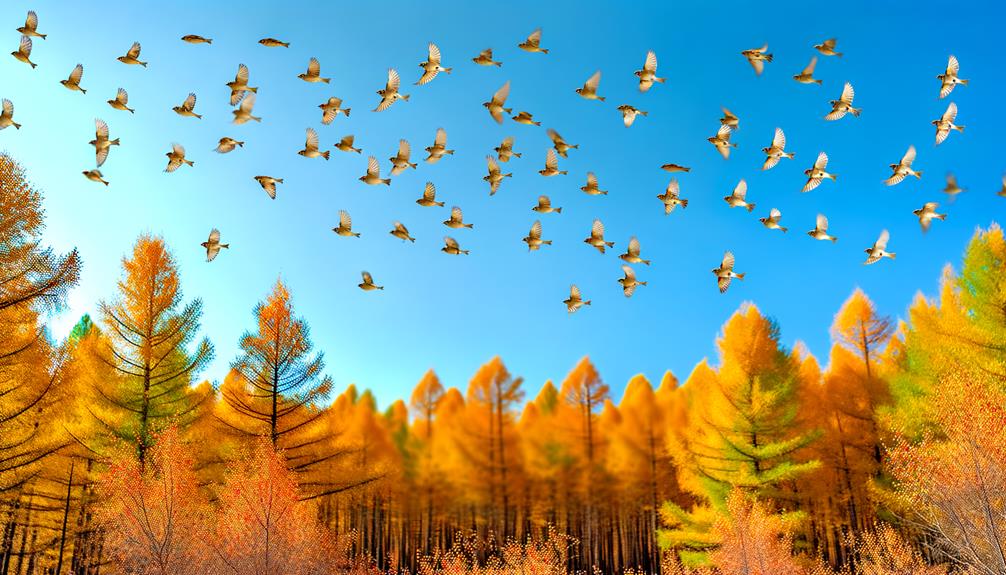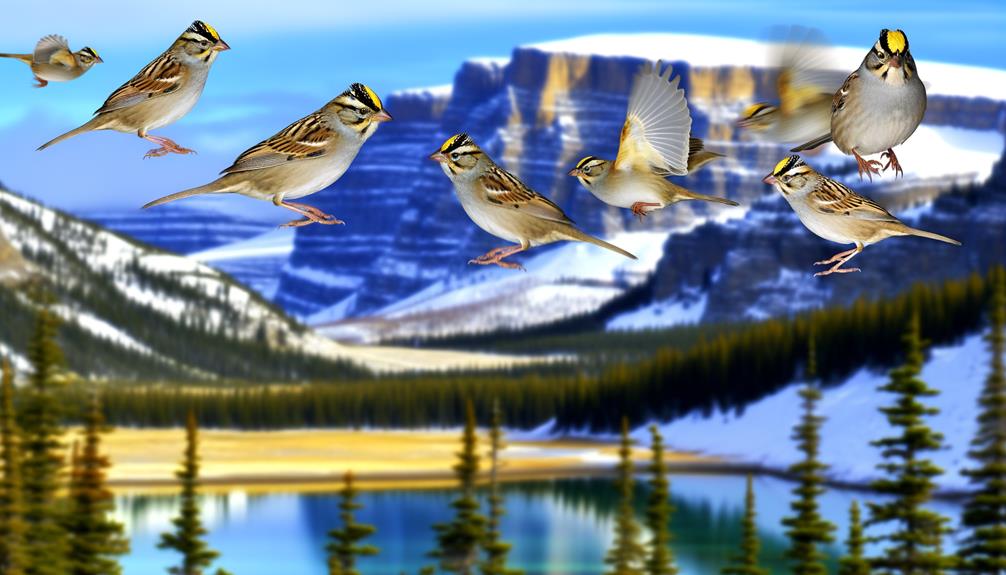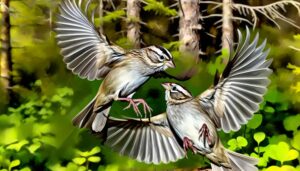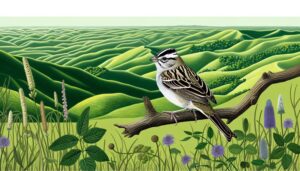How to Track Golden-Crowned Sparrows as They Migrate
Golden-Crowned Sparrows migrate from the tundra regions of Alaska and northwestern Canada to the Pacific Coast in late September to early October. They navigate through Earth's magnetic field and celestial cues, stopping at staging areas for rest.
These birds' journeys are influenced by changing daylight hours and temperature. During migration, they face harsh weather and depend on substantial energy reserves.
They winter along the Pacific coast from southern British Columbia to central California, inhabiting coastal scrublands and urban gardens. Observing these adaptations and behaviors reveals the remarkable strategies sparrows use to thrive during migration.

Key Takeaways
- Golden-Crowned Sparrows migrate from Alaska to the Pacific Coast in late September to early October.
- Migration is triggered by changes in daylight hours and temperature.
- They follow well-defined flight paths along the Pacific Coast.
- Key stopover sites include coastal regions and mountain valleys.
- Migration involves group travel and adjusting routes for weather conditions.
Migration Overview

During the fall, Golden-Crowned Sparrows begin their migration from their breeding grounds in Alaska and northwestern Canada to wintering habitats along the Pacific Coast of the United States. This journey spans hundreds of miles and is critical for their survival during the colder months.
These sparrows navigate using the Earth's magnetic field, celestial cues, and possibly even olfactory signals. En route, they stop at various staging areas to rest and refuel, taking advantage of abundant food supplies.
Their migratory patterns are influenced by changing daylight hours and temperature variations, ensuring they reach their wintering grounds where conditions are more favorable. This annual migration highlights the sparrows' remarkable adaptability and instinctual drive for survival.
Breeding Grounds
Golden-Crowned Sparrows establish their breeding grounds in the dense, shrubby tundra and boreal forest regions of Alaska and northwestern Canada. They prefer areas with abundant low-lying vegetation that provides both concealment and nesting material.
During the breeding season, these sparrows exhibit territorial behavior, with males singing to defend their chosen area. Nest-building typically occurs on or near the ground, utilizing grasses, moss, and animal fur to construct well-hidden nests.
They lay 3-5 eggs per clutch, which are primarily incubated by the female. The chicks hatch after approximately two weeks and fledge within another ten days.
This breeding strategy ensures that offspring are ready to migrate before the harsh Arctic winter sets in, maximizing their chances for survival.
Wintering Habitats

As winter approaches, Golden-Crowned Sparrows migrate to the milder climates of the Pacific coast, ranging from southern British Columbia to central California. These regions offer diverse habitats that cater to their survival needs. Mainly, they inhabit areas with dense shrubbery and open fields, providing both cover and foraging opportunities.
| Habitat Type | Description |
|---|---|
| Coastal Scrublands | Dense shrubs and bushes near coastal areas |
| Agricultural Fields | Open fields with scattered vegetation |
| Urban Gardens | Residential areas with bird feeders and gardens |
| Riparian Zones | Vegetated areas along rivers and streams |
These habitats not only provide ample food sources like seeds and insects but also offer protection from harsh weather and predators. Consequently, Golden-Crowned Sparrows thrive in these wintering grounds, maintaining their health and energy for the coming breeding season.
Migration Routes
Golden-crowned Sparrows typically follow well-defined flight paths along the Pacific Coast during their migration. Key stopover sites include coastal regions and mountain valleys where they find abundant food resources.
The seasonal timing patterns of their migration are closely linked to changes in daylight and temperature, ensuring they arrive at their breeding and wintering grounds at best periods.
Typical Flight Paths
During their annual migration, golden-crowned sparrows typically follow well-defined routes that stretch from their breeding grounds in Alaska and western Canada to their wintering habitats along the Pacific coast of the United States. These birds exhibit remarkable navigational skills, using a combination of geomagnetic cues, star patterns, and environmental landmarks to traverse vast distances.
Key components of their flight paths include:
- Directness: They minimize detours to conserve energy.
- Altitude variation: They adjust flight altitude based on weather patterns and air currents.
- Timing: Migration occurs primarily during specific seasons, aligning with food availability.
- Group travel: Sparrows often migrate in flocks, enhancing navigation accuracy and predator avoidance.
Understanding these flight paths helps researchers monitor population health and migration ecology.
Key Stopover Sites
Key stopover sites along their migration routes provide golden-crowned sparrows with essential rest and refueling opportunities, safeguarding their long journey remains sustainable and efficient.
These sites, often riparian zones, coastal regions, and agricultural fields, offer abundant food sources such as seeds and insects. The sparrows utilize these habitats to replenish fat reserves, necessary for their energy-intensive migrations.
Data from banding studies reveal that golden-crowned sparrows favor consistent stopover locations annually, indicating the reliability of these sites.
Habitat preservation at these key stopovers is crucial for the species' migratory success. Conservation efforts should prioritize maintaining the ecological integrity of these areas to support the sparrows' intricate migratory patterns and safeguard their continued survival.
Seasonal Timing Patterns
Tracking the seasonal timing patterns of golden-crowned sparrows reveals distinct migration routes that align with changes in daylight and temperature. These routes ensure ideal conditions for feeding, breeding, and resting.
Golden-crowned sparrows typically set off on their northward journey in early spring, guided by increasing daylight and warming temperatures. Conversely, they migrate southward as days shorten and temperatures drop in late fall.
Key points in their migration include:
- Departure Timing: Northward migration begins in March-April; southward in September-October.
- Route Fidelity: They consistently follow the same paths each year.
- Stopover Sites: Critical for rest and refueling; crucial for survival.
- Environmental Cues: Changes in photoperiod and temperature trigger migration.
These patterns illustrate the sparrows' intricate adjustment to seasonal changes.
Timing and Seasons

Golden-crowned sparrows start their migration in the fall, driven by changes in daylight and temperature. As the days shorten and temperatures drop, these environmental cues signal the birds to begin their southward journey.
Researchers observe that the migration typically starts in late September to early October. During this period, sparrows leave their breeding grounds in Alaska and western Canada, traveling to wintering areas along the Pacific Coast, from southern British Columbia to central California.
The timing ensures they avoid the harsh northern winters and find abundant food sources in milder climates. This migration is essential for their survival, aligning perfectly with seasonal shifts to optimize energy efficiency and resource availability.
Such precise timing highlights their adaptation to seasonal changes.
Navigational Skills
As these sparrows embark on their migratory journey, their remarkable navigational skills guide them across vast distances with pinpoint accuracy. Golden-crowned sparrows utilize a combination of environmental cues and innate mechanisms to navigate. They rely on:
- Celestial Navigation: Using the sun, stars, and Earth's magnetic field to orient themselves.
- Landmark Recognition: Remembering specific geographical features to aid in route finding.
- Genetic Programming: Innate knowledge passed through generations, enabling precise migratory paths.
- Social Learning: Observing and following the experienced birds within their flock.
Their ability to integrate these diverse navigational strategies ensures they reach their breeding and wintering grounds effectively. This intricate system showcases the sparrows' sophisticated adaptation to their migratory lifestyle, balancing freedom with scientific precision.
Endurance and Challenges

Migratory journeys for golden-crowned sparrows demand immense endurance, as they face numerous challenges such as harsh weather conditions, predation, and resource scarcity. These small birds traverse vast distances between their breeding and wintering grounds, requiring significant energy reserves. They must rely on fat stores accumulated before migration and refuel at various stopover sites along the way.
Predators, including raptors and mammals, pose a constant threat, necessitating vigilance and evasive maneuvers. Additionally, the availability of food resources can be unpredictable, forcing sparrows to adapt their foraging strategies. Despite these obstacles, golden-crowned sparrows exhibit remarkable resilience, driven by instinctual imperatives to reach best-suited habitats for breeding and survival.
Their migratory endurance exemplifies nature's intricate balance of challenge and perseverance.
Weather Impact
Weather conditions play an essential role in shaping the migratory patterns and survival strategies of golden-crowned sparrows. These birds must navigate through diverse climatic challenges, making precise timing vital for their journey. Adverse weather can delay migration, affecting their energy reserves and overall fitness.
Cold fronts, for instance, can prompt early departures, while favorable tailwinds facilitate faster travel.
- Temperature fluctuations: Sparrows adjust their routes to avoid extreme cold or heat.
- Storm patterns: Severe storms can force detours, increasing travel distance.
- Precipitation levels: Heavy rain impacts visibility and food availability.
- Wind conditions: Favorable winds aid in conserving energy, while headwinds pose significant challenges.
Understanding these weather-related influences is essential for comprehending their migratory behavior and ensuring their survival.
Human Interactions

Golden-crowned sparrows often rely on backyard feeders during migration. This can impact local gardens as they forage for seeds and insects.
This interaction highlights the need for conservation efforts to guarantee these birds have safe and adequate resources. Understanding these dynamics can help inform strategies to support both sparrow populations and garden ecosystems.
Feeding During Migration
During their migratory journey, golden-crowned sparrows often benefit from human-provided food sources, which can impact their feeding patterns and energy reserves. These birds, typically foraging on seeds and insects, may frequent bird feeders and gardens, leading to alterations in their natural diet and foraging behavior. The availability of easy food can influence their stopover duration and migration efficiency.
Human interactions can provide:
- Supplemental nutrition: Access to varied food sources beyond their natural diet.
- Increased energy reserves: Opportunities to store fat for long flights.
- Altered migration timing: Potential delays or advances in departure based on food abundance.
- Behavioral changes: Shifts in foraging habits due to predictable feeding locations.
Understanding these interactions is essential for conservation and managing human impact on migratory patterns.
Impact on Gardens
Curiously, how do human interactions impact gardens visited by golden-crowned sparrows during their migration?
The presence of these sparrows can profoundly alter garden ecosystems. Human activities such as planting native vegetation and providing bird feeders can attract these birds, offering them vital nourishment. However, pesticide use poses a threat, potentially harming sparrows directly or reducing their food sources.
The birds' foraging behavior may also help control insect populations, promoting plant health. Conversely, their feeding on seeds and fruits could impact garden yields.
Observing these interactions provides insight into the delicate balance between human activities and wildlife needs, highlighting the dual roles humans play as both stewards and disruptors of natural habitats during sparrow migration.
Conservation Efforts Needed
Effective conservation efforts require a multifaceted approach that involves both habitat preservation and minimizing harmful human activities. Protecting the breeding and wintering grounds of Golden-Crowned Sparrows is vital. Human interactions often disrupt these habitats, leading to population declines.
To address this, conservationists recommend:
- Habitat Restoration: Rehabilitating degraded areas to support sparrow populations.
- Legislation: Implementing and enforcing laws to protect migratory routes and critical habitats.
- Education: Raising public awareness about the sparrows' ecological role and the importance of conservation.
- Research: Conducting studies to better understand migration patterns and threats.
These measures, when combined, can help maintain healthy populations of Golden-Crowned Sparrows, ensuring they continue to thrive in their natural environments.
Conservation Efforts
Conservationists implement targeted measures to protect the Golden-Crowned Sparrow's habitats during their migration periods. They prioritize preserving critical stopover sites, guaranteeing these areas remain undisturbed and rich in resources. Effective strategies include habitat restoration, legal protection, and public education. By fostering collaboration among governmental agencies, non-profits, and local communities, they aim to mitigate threats like habitat destruction and climate change.
| Strategy | Description | Impact |
|---|---|---|
| Habitat Restoration | Revitalizing degraded environments | Increased food availability |
| Legal Protection | Enforcing laws to safeguard habitats | Reduced human interference |
| Public Education | Raising awareness and involvement | Enhanced local support |
| Collaborative Efforts | Partnering with diverse stakeholders | Thorough conservation |
These efforts guarantee the Golden-Crowned Sparrow can migrate safely, maintaining their population and ecological role.
Conclusion
To sum up, golden-crowned sparrows' migration is an extraordinary journey characterized by precise timing, lengthy routes, and numerous challenges. They travel from breeding areas to wintering habitats, showing resilience and adaptability. Climate conditions greatly affect their migration, and human activities present both risks and conservation possibilities.
As the saying goes, 'A journey of a thousand miles starts with a single step,' depicting the sparrows' enduring determination throughout their migration. Conservation efforts continue to be essential to guarantee their survival and ongoing migrations.






